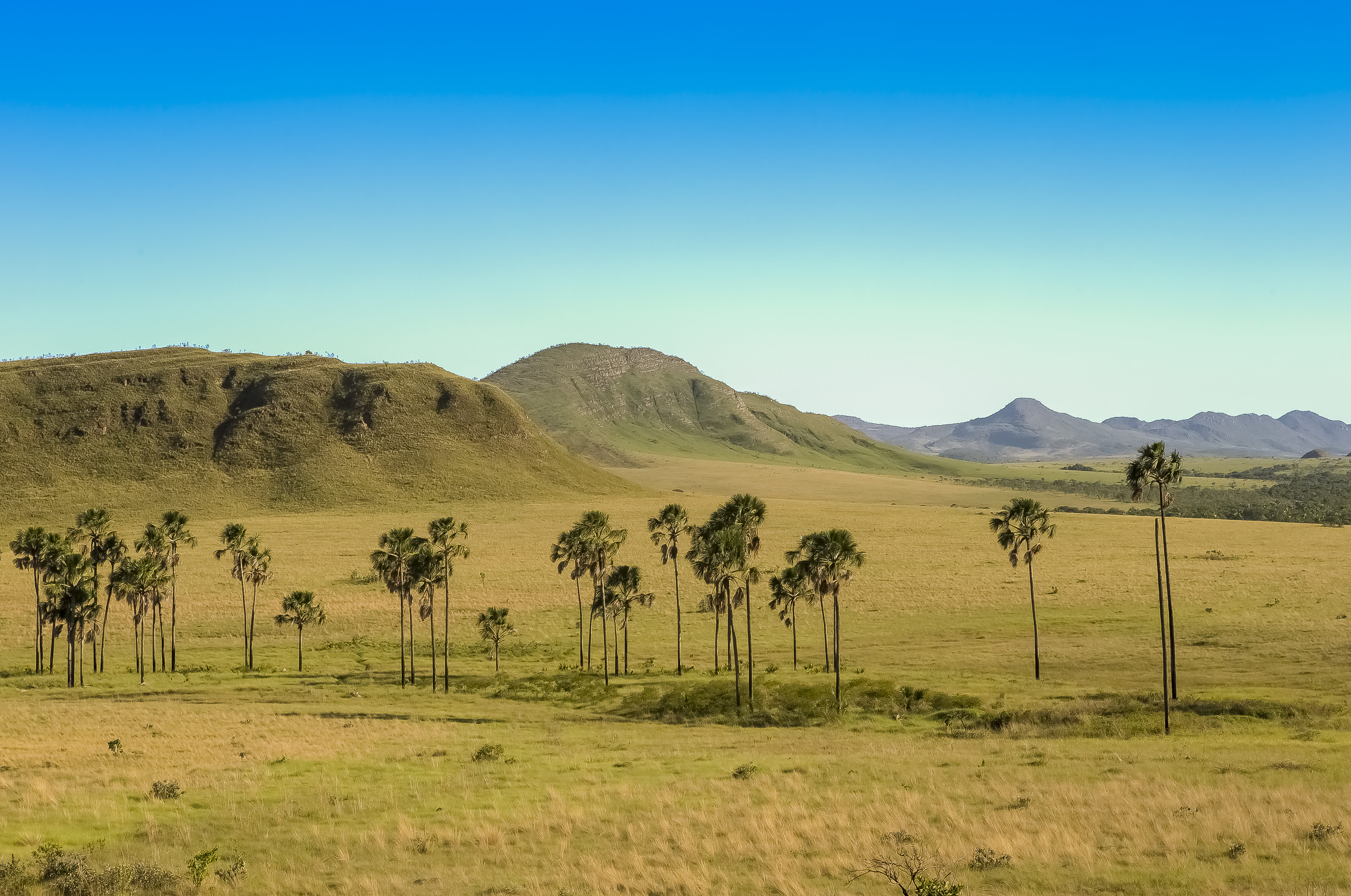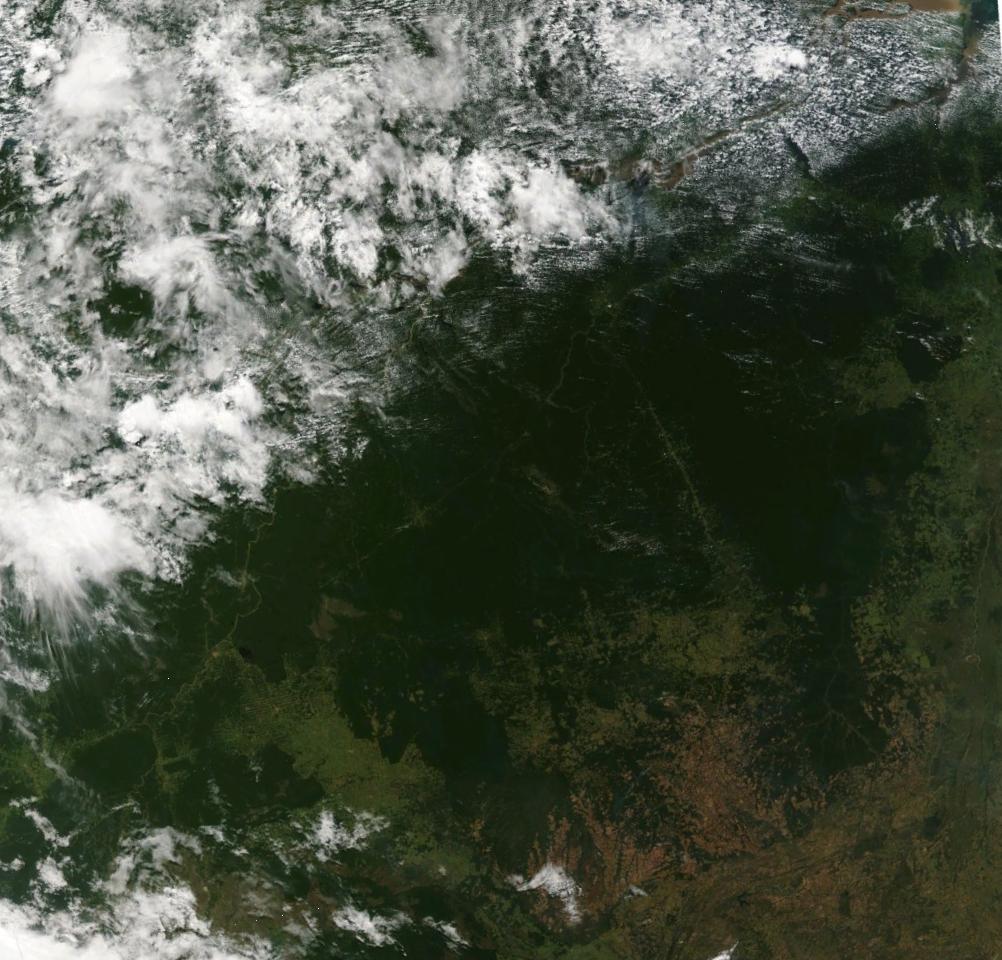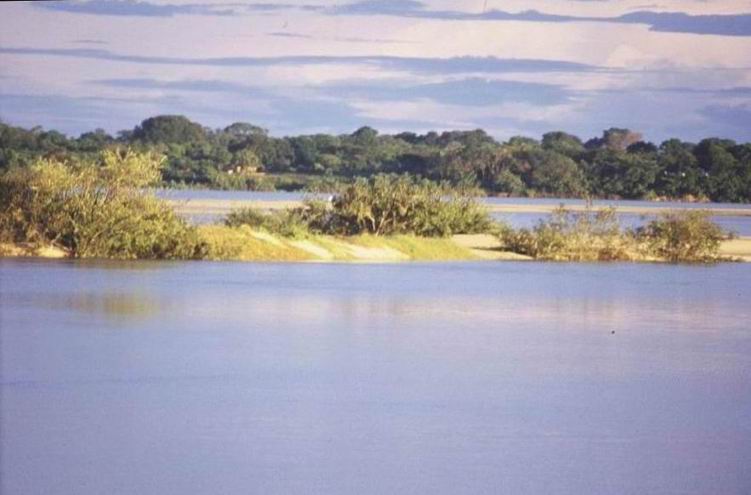|
São Miguel Do Araguaia
São Miguel do Araguaia is a city in northwest Goiás state, Brazil. It is the northernmost municipality in Goiás, one of the largest too, and a major producer of cattle. São Miguel is located in the São Miguel do Araguaia Microregion and is one of the most distant cities from the state capital, Goiânia, which is 486 kilometers away. There are highway connections with Araguaçu, state of Tocantins, 63 kilometers to the north; Nova Crixás, 102 kilometers to the south; and Luiz Alves, 45 kilometers to the west, on the Araguaia River. Highway connections are made from Goiânia by GO-070 / Goianira / Inhumas / Itaberaí / BR-070 / Goiás / GO-164 / Araguapaz / Nova Crixás. History The region received its first settlers in 1952 with the arrival of José Pereira do Nascimento, Lozorik Belem, and Ovídio Martins de Souza who bought large areas of land and began to raise cattle. José Pereira do Nascimento was a Spiritualist healer and attracted people seeking a cure for ... [...More Info...] [...Related Items...] OR: [Wikipedia] [Google] [Baidu] |
Goiás
Goiás () is a Brazilian States of Brazil, state located in the Central-West Region, Brazil, Central-West region. Goiás borders the Federal District (Brazil), Federal District and the states of (from north clockwise) Tocantins, Bahia, Minas Gerais, Mato Grosso do Sul and Mato Grosso. The state capital is Goiânia. With 7.2 million inhabitants, Goiás is the most populous state in the Central-West region and the List of Brazilian states by population, 11th most populous in the country. It has the List of Brazilian federative units by gross regional product, ninth largest economy among Brazilian federative units. In Brazil's geoeconomic division, Goiás belongs to the Centro-Sul (Center-South), being the northernmost state of the southern portion of Brazil. The state has 3.3% of the Brazilian population and is responsible for 2.7% of the Brazilian GDP. The history of Goiás dates back to the beginning of the 18th century, with the arrival of pioneers from São Paulo. The Rio Verm ... [...More Info...] [...Related Items...] OR: [Wikipedia] [Google] [Baidu] |
Tocantins (state)
Tocantins () is one of the 26 states of Brazil. It is the newest state, formed in 1988 and encompassing what had formerly been the northern two-fifths of the state of Goiás. Tocantins covers and had an estimated population of 1,496,880 in 2014. Construction of its capital, Palmas, began in 1989; most of the other cities in the state date to the Portuguese colonial period. With the exception of Araguaína, there are few other cities with a significant population in the state. The government has invested in a new capital, a major hydropower dam, railroads and related infrastructure to develop this primarily agricultural area. The state has 0.75% of the Brazilian population and is responsible for 0.5% of the Brazilian GDP. Tocantins has attracted hundreds of thousands of new residents, primarily to Palmas. It is building on its hydropower resources. The Araguaia and Tocantins rivers drain the largest watershed that lies entirely inside Brazilian territory. The Rio Tocantins ... [...More Info...] [...Related Items...] OR: [Wikipedia] [Google] [Baidu] |
List Of Municipalities In Goiás
This is a list of the municipalities in the state of Goiás (GO), in the Central-West Region of Brazil. Goiás is divided into 246 municipalities, which are grouped into 18 microregions, which are grouped into 5 mesoregions. Ordered by regions Ordered by population List of municipalities in Goiás by population, in descending order, based on estimates from IBGE for 1 July 2005. More than 500,000 inhabitants More than 100,000 inhabitants More than 50,000 inhabitants More than 25,000 inhabitants More than 10,000 inhabitants More than 5,000 inhabitants Fewer than 5,000 inhabitants Ordered by area and population This is a list of municipalities in the state of Goiás, Brazil. Population figures are estimates from 2005. Area figures are from 2002. See also * Geography of Brazil * List of cities in Brazil {{DEFAULTSORT:List of municipalities in Goias * Goias Municipalities A municipality is usually a single administrative division havi ... [...More Info...] [...Related Items...] OR: [Wikipedia] [Google] [Baidu] |
Uruaçu
Uruaçu is a city and municipality in north Goiás state, Brazil. Geography Uruaçu is located north of Anápolis and Goiânia on the important interstate highway BR-153, which links Brasília to Belém. It is 269 km. from Goiânia and 244 km. from Brasília. It belongs to the Porangatu Microregion. Municipal boundaries are with: *North: Nova Iguaçu de Goiás and Campinorte Campinorte is a municipality in north-central Goiás state, Brazil. The population was 12,764 (2020) in a total area of 1,068 km2. Location Campinorte is located on the important Belém-Brasília, BR-153, and is 315 kilometers from the ... *South: Hidrolina and Santa Rita do Novo Destino *East: Niquelândia *West: Hidrolina On the west the municipal boundary follows the Serra Dourada mountains, where the Passa Três river has its source and supplies the city with its drinking water. On the east the boundary is formed by the Serra da Mesa Dam, Serra da Mesa reservoir (43 meters de ... [...More Info...] [...Related Items...] OR: [Wikipedia] [Google] [Baidu] |
United Nations
The United Nations (UN) is the Earth, global intergovernmental organization established by the signing of the Charter of the United Nations, UN Charter on 26 June 1945 with the stated purpose of maintaining international peace and international security, security, to develop friendly Diplomacy, relations among State (polity), states, to promote international cooperation, and to serve as a centre for harmonizing the actions of states in achieving those goals. The United Nations headquarters is located in New York City, with several other offices located in United Nations Office at Geneva, Geneva, United Nations Office at Nairobi, Nairobi, United Nations Office at Vienna, Vienna, and The Hague. The UN comprises six principal organizations: the United Nations General Assembly, General Assembly, the United Nations Security Council, Security Council, the United Nations Economic and Social Council, Economic and Social Council, the International Court of Justice, the United Nations Se ... [...More Info...] [...Related Items...] OR: [Wikipedia] [Google] [Baidu] |
Minas Gerais
Minas Gerais () is one of the 27 federative units of Brazil, being the fourth largest state by area and the second largest in number of inhabitants with a population of 20,539,989 according to the 2022 Brazilian census, 2022 census. Located in the Southeast Region, Brazil, Southeast Region of the country, it is bordered to south and southwest by São Paulo (state), São Paulo; Mato Grosso do Sul to the west; Goiás and the Federal District (Brazil), Federal District to the northwest; Bahia to the north and northeast; Espírito Santo to the east; and Rio de Janeiro (state), Rio de Janeiro to the southeast. The state's capital and largest city, Belo Horizonte, is a major urban and finance center in Brazil, being the List of largest cities in Brazil#Top 115 most populous cities and state capitals, sixth most populous municipality in the country while its Greater Belo Horizonte, metropolitan area ranks as the List of metropolitan areas in Brazil, third largest in Brazil with just ov ... [...More Info...] [...Related Items...] OR: [Wikipedia] [Google] [Baidu] |
Araguapaz
Araguapaz is a municipality in northwestern Goiás state, Brazil. The population is 7,783 (2020) in a total area of 2,194 km2. It is a major producer of cattle. Location and Municipal Boundaries Araguapaz is located 268 kilometers northwest of the state capital, Goiânia, in the Rio Vermelho Microregion. Connections with Goiânia are made by highways GO-070 / Goianira / Itaberaí / Goiás / GO-164 / Faina. Highway GO-530 continues northwest for 53 kilometers to Aruanã on the Araguaia River. Municipal boundaries: *North: Mozarlândia *South: Faina *East: Morro Agudo de Goiás *West: Aruanã and Matrinchã It is in the mini-basin of the Rio do Peixe, a tributary of the Araguaia River. Another important river in the region is the Tesouras. Demographic and Political Data *Population density: 3.41 inhabitants/km2 (2007) *Population growth rate 2000/2007: 0.33.% *Urban population: 5,218 *Rural population: 2,264 *Eligible voters: 5,676 (12/2007) *City government ... [...More Info...] [...Related Items...] OR: [Wikipedia] [Google] [Baidu] |
Goiás, Goiás
Goiás (also known as Goiás Velho, Old Goiás) is a Municipalities of Brazil, municipality in the state of Goiás in Brazil. Its population was 22,381 (2020 est.) and its area is 3,108 km2. It is the former Capital (political), capital of the state and preserves much of its colonial heritage. In 2002, it became a UNESCO World Heritage Site. World Heritage Site It used to be the old state capital of Goiás up until 1937 when the government seat was transferred to the then-recently built Goiânia. It was founded by the famed Bandeirante explorer Bartolomeu Bueno da Silva, nicknamed the ''Anhangüera'', and was called in colonial times Vila Boa de Goyaz ("Good Village of Goyaz" in archaic Portuguese). Given its historical importance, the historical center of Goiás was included on the UNESCO's World Heritage list in 2001. Location Municipal boundaries: *North: Faina, Goiás, Faina *South: Mossâmedes *East: Itaberaí *West: Itapirapuã and Matrinchã *Districts: Calcilândia, B ... [...More Info...] [...Related Items...] OR: [Wikipedia] [Google] [Baidu] |
Itaberaí
Itaberaí is a municipality in central Goiás state, Brazil. Itaberaí is a large producer of agricultural products including corn, rice, soybeans, tomatoes, and sugarcane. Location Itaberaí is located 92 kilometers north-west of Goiânia on state highway GO-070 and 36 kilometers southeast of the former capital, Cidade de Goiás. Itaberaí is part of the Anápolis Microregion. *Neighboring municipalities: Americano do Brasil, Anicuns, Araçu, Avelinópolis, Cidade de Goiás, Heitoraí, Itaguari, Itaguaru, Itauçu, Mossâmedes, Taquaral de Goiás and Uruana. *Districts (distritos), villages (povoados), and hamlets (aglomerados): – Povoados: Congomé, Santa Rita and Santo Antônio. – Aglomerados: Lobeira, São Benedito and São José do Retiro. Climate The climate is humid tropical with regular rains in the summer. The most important rivers are Rio das Pedras, Rio Uru, which has its source in the Serra Dourada and forms a boundary with the municipality of Goiás. De ... [...More Info...] [...Related Items...] OR: [Wikipedia] [Google] [Baidu] |
Inhumas
Inhumas () is a municipality in central Goiás state, Brazil. The population was 52 866 (2019 estimate) in a total area of 613.3 km² (10/10/2002). Inhumas is a large producer of sugarcane, poultry, milk, and meat. Distances and Location *Distance to the state capital: 54 km. *Distance to regional center (Anápolis): 73 km. *Highway connections: state highway GO-070 north from Goiânia, through Goianira and then 22 km. north. Inhumas is on the Meia Ponte River. Neighboring municipalities are Itauçu, Petrolina, Damolândia, Brazabrantes, Caturaí, and Araçu. Demographics *Population growth rate 1996/2006: 1.05.% *Population in 2007: 44,983 *Population in 1980: 31,430 *Urban population in 2007: 42,421 *Rural population in 2007: 2,562 The economy Main agricultural activities were cattle raising (72,800 head in 2005) and agriculture. Because of the fertility of the soil and abundance of water Inhumas has a large and varied agricultural production. The ma ... [...More Info...] [...Related Items...] OR: [Wikipedia] [Google] [Baidu] |
Goianira
Goianira is a municipality in central Goiás state, Brazil, located 32 kilometers northwest of the state capital, Goiânia. The population was 45,296 (2020) with a total area of 200.4 km2 (10/10/2002). Goianira is becoming a major producer of shoes. Goianira is four kilometers east of highway BR-457 / GO-415, which links Goiânia to Aruanã. It is in the Meia Ponte River valley. Neighboring municipalities are: *north: Caturaí *south: Goiânia and Trindade *east: Santo Antônio de Goiás *west: Avelinópolis History Goianira was founded in 1920 by Padre Pelágio Sáuter, with the name São Geraldo. In 1935, São Geraldo became a district. In 1940, it served as a base for the construction of the new capital of the state of Goiás, and the name was changed to Itaim. This name lasted until 1942 when it was changed to Itaité. After a popular movement, the name was changed back to São Geraldo. This name lasted until 1943, when it was given its current name, Goiani ... [...More Info...] [...Related Items...] OR: [Wikipedia] [Google] [Baidu] |
Araguaia River
The Araguaia River ( , Karajá language, Karajá: ♂ ''Berohokỹ'' [beɾohoˈkə̃], ♀ ''Bèrakuhukỹ'' [bɛɾakuhuˈkə̃]) is one of the major rivers of Brazil, and a tributary of the Tocantins River. Geography The Araguaia River comes from Goiás-Mato Grosso south borders. From there it flows northeast to a junction with the Tocantins River, Tocantins near the town of São João. Along its course, the river forms the border between the states of Goiás, Mato Grosso, Tocantins and Pará. Roughly in the middle of its course the Araguaia splits into a fork (with the western stream retaining the name Araguaia and the eastern one being called the Javaés River). These later reunite, forming the Ilha do Bananal, the world's largest river island. The vein of the Javaés forms a broad inland where it pours back into the main Araguaia, a 100,000 hectare expanse of igapós or flooded forest, blackwater river channels, and oxbow lakes called Cantão, protected by the Cantão State Par ... [...More Info...] [...Related Items...] OR: [Wikipedia] [Google] [Baidu] |




